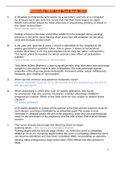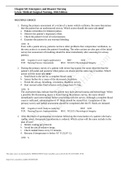1Maternity HESI 1 &2 Test Bank 2021
1.A 38-week primigravida who works as a secretary and sits at a computer for 8 hours each day tells the nurse that her feet have begun to swell. Which instruction would be most effective in preventing pooling of blood in
the lower extremities?
Move about every hour
Pooling of blood in the lower extremities results from the enlarged uterus exerting pressure on the pelvic veins. Moving about every hour will straighten out the pelvic veins and increase venous return.
2.A 26-year-old, gravida 2, para 1 client is admitted to the hospital at 28-
weeks gestation in preterm labor. She is given 3 doses of terbutaline sulfate (Brethine) 0.25 mg subcutaneously to stop her labor contractions. The nurse plans to monitor for which primary side effect of terbutaline sulfate?
Tachycardia and a feeling of nervousness
Terbutaline sulfate (Brethine), a beta-sympathomimetic drug, stimulates beta-adrenergic receptors in the uterine muscle to stop contractions. The beta-adrenergic agonist properties of the drug may cause tachycardia, increased cardiac output, restlessness, headache, and a feeling of "nervousness".
3.When do the anterior and posterior fontanels close?
anterior fontanel closes at 12 to 18 months and the posterior by the end of the second month.
4.When assessing a client who is at 12-weeks gestation, the nurse recommends that she and her husband consider attending childbirth preparation classes. When is the best time for the couple to attend these classes?
30 weeks gestation
at 30 weeks gestation is closest (of the options) to the time parents would be ready for such classes. Learning is facilitated by an interested pupil! The couple is most interested in childbirth toward the end of the pregnancy when they are psychologically ready for the termination of the pregnancy, and the birth of their child is an immediate concern.
5.The nurse should encourage the laboring client to begin pushing when... the cervix is completely dilated.
Pushing begins with the second stage of labor, i.e., when the cervix is completely dilated at 10 cm (C). If pushing begins before the cervix is completely dilated the cervix
can become edematous and may never completely dilate, necessitating an operative
delivery. Many primigravida’s begin active labor 100% effaced and then proceed to dilate. 26.The nurse instructs a laboring client to use accelerated-blow breathing. The client begins to complain of tingling fingers and dizziness. What action should the nurse take?
Have the client breathe into her cupped hands
Tingling fingers and dizziness are signs of hyperventilation (blowing off too much carbon dioxide). Hyperventilation is treated by retaining carbon dioxide. This can be facilitated by breathing into a paper bag or cupped hands.
7.Twenty-four hours after admission to the newborn nursery, a full-term male infant develops localized edema on the right side of his head. The nurse knows that, in the newborn, an accumulation of blood between the periosteum and skull which does not cross the suture line is a newborn variation known as...
a cephalohematoma, caused by forceps trauma and may last up to 8 weeks.
Cephalohematoma, a slight abnormal variation of the newborn, usually arises within the
first 24 hours after delivery. Trauma from delivery causes capillary bleeding between
the periosteum and the skull.
8.When does the head return to its normal shape?
7-10 days
9.What did Nurse theorist Reva Rubin describe?
The initial postpartum period as the "taking-in phase," which is characterized by maternal reliance on others to satisfy the needs for comfort, rest, nourishment, and closeness to families and the newborn.
10.A couple, concerned because the woman has not been able to conceive, is referred to a healthcare provider for a fertility workup and a hysterosalpingography is scheduled. Which post procedure complaint indicates that the fallopian tubes are patent?
Shoulder pain
If the tubes are patent (open), pain is referred to the shoulder from a sub
diaphragmatic collection of peritoneal dye/gas.
11.Which nursing intervention is most helpful in relieving postpartum uterine contractions or "afterpains?"
Lying prone with a pillow on the abdomen
Lying prone keeps the fundus contracted and is especially useful with multiparas, who 3commonly experience afterpains due to lack of uterine tone.
12.Which maternal behavior is the nurse most likely to see when a new mother receives her infant for the first time?
Her arms and hands receive the infant and she then traces the infant's profile
with her fingertips.
Attachment/bonding theory indicates that most mothers will demonstrate behaviors described in during the first visit with the newborn, which may be at delivery or later.
13.A client at 32-weeks gestation is hospitalized with severe pregnancy-
induced hypertension (PIH), and magnesium sulfate is prescribed to control the symptoms. Which assessment finding indicates the therapeutic drug level has been achieved?
A decreased in respiratory rate from 24 to 16
Magnesium sulfate, a CNS depressant, helps prevent seizures. A decreased respiratory
rate indicates that the drug is effective. (Respiratory rate below 12 indicates toxic effects.)
14.Urinary output must be monitored when administering magnesium sulfate and should be at least 30 ml per hour. (The therapeutic level of magnesium sulfate for a PIH client is
4.8 to 9.6 mg/dl.) What is the therapeutic level of magnesium sulfate?
The therapeutic level of magnesium sulfate for a PIH client is 4.8 to 9.6 mg/dl. What does it help prevent? helps prevent seizures
What indicates toxic levels? 3
Respiratory rate below 12 indicates toxic effects.
Urine output of less than 100 ml/4 hours
Absent DTRs
15.Twenty minutes after a continuous epidural anesthetic is administered, a laboring client's blood pressure drops from 120/80 to 90/60. What action should the nurse take?
Place woman in a lateral position
The nurse should immediately turn the woman to a lateral position, place a pillow or wedge under the right hip to deflect the uterus, increase the rate of the main line IV infusion, and administer oxygen by face mask at 10-12 L/min. If the blood pressure remains low, especially if it further decreases, the anesthesiologist/healthcare provider should be notified immediately.
16.A client at 28-weeks gestation calls the antepartum clinic and states that she is experiencing a small amount of vaginal bleeding which she describes 4as bright red. She further states that she is not experiencing any uterine contractions or abdominal pain. What instruction should the nurse provide?
Come to the clinic today for an ultrasound
Third trimester painless bleeding is characteristic of a placenta previa. Bright red bleeding may be intermittent, occur in gushes, or be continuous. Rarely is the first incidence life-threatening, nor cause for hypovolemic shock. Diagnosis is confirmed by transabdominal ultrasound.
17.An off-duty nurse finds a woman in a supermarket parking lot delivering an infant while her husband is screaming for someone to help his wife. Which intervention has the highest priority?
Put the newborn to breast
Putting the newborn to breast will help contract the uterus and prevent a postpartum hemorrhage--this intervention has the highest priority.
18.A pregnant client with mitral stenosis Class III is prescribed complete bedrest. The client asks the nurse, "Why must I stay in bed all the time?" Which response is best for the nurse to provide this client?
Complete bedrest decreases oxygen needs and demands on the heart muscle
tissue.
To help preserve cardiac reserves, the woman may need to restrict her activities and complete bedrest is often prescribed.
19.The nurse is teaching care of the newborn to a group of prospective parents and describes the need for administering antibiotic ointment into the eyes of the newborn. Which infectious organism will this treatment prevent from harming the infant?
Gonorrhea
Erythromycin ointment is instilled into the lower conjunctiva of each eye within 2 hours after birth to prevent ophthalmic neonatorum, an infection caused by gonorrhea, and inclusion conjunctivitis, an infection caused by chlamydia. The infant may be exposed to these bacteria when passing through the birth canal.
20.The nurse is teaching a woman how to use her basal body temperature (BBT) pattern as a tool to assist her in conceiving a child. Which temperature pattern indicates the occurrence of ovulation, and therefore, the best time for intercourse to ensure conception?
Between the time the temperature falls and rises.
In most women, the BBT drops slightly 24 to 36 hours before ovulation and rises 24 to
72 hours after ovulation, when the corpus luteum of the ruptured ovary produces





